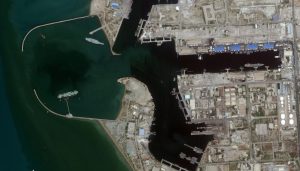As tensions remain high between Iran and the U.S., the Islamic Republic appears to have constructed a new mock-up of an aircraft carrier off its southern coast for potential live-fire drills.
The faux foe, seen in satellite photographs obtained Tuesday by The Associated Press, resembles the Nimitz-class carriers that the U.S. Navy routinely sails into the Persian Gulf from the Strait of Hormuz, its narrow mouth where 20% of all the world’s oil passes through.
While not yet acknowledged by Iranian officials, the replica’s appearance in the port city of Bandar Abbas suggests Iran’s paramilitary Revolutionary Guard is preparing an encore of a similar mock-sinking it conducted in 2015.
It also comes as Iran announced Tuesday it will execute a man it accused of sharing details on the movements of the Guard’s Gen. Qassem Soleimani, whom the U.S. killed in a January drone strike in Baghdad.
The replica carries 16 mock-ups of fighter jets on its deck, according to satellite photos taken by Maxar Technologies. The vessel appears to be some 200 meters (650 feet) long and 50 meters (160 feet) wide. A real Nimitz is over 300 meters (980 feet) long and 75 meters (245 feet) wide.
The fake carrier sits just a short distance away from the parking lot in which the Guard unveiled over 100 new speedboats in May, the kind it routinely employs in tense encounters between Iranian sailors and the U.S. Navy. Those boats carry both mounted machine guns and missiles.
The mock-up, which first began to be noticed among defense and intelligence analysts in January, strongly resembles a similar one used in February 2015 during a military exercise called “Great Prophet 9.”
During that drill, Iran swarmed the fake aircraft carrier with speedboats firing machine guns and rockets. Surface-to-sea missiles later targeted and destroyed the fake carrier.
“American aircraft carriers are very big ammunition depots housing a lot of missiles, rockets, torpedoes and everything else,” the Guard’s then-navy chief, Adm. Ali Fadavi, said on state television at the time.
That drill, however, came as Iran and world powers remained locked in negotiations over Tehran’s nuclear program. Today, the deal born of those negotiations is in tatters. President Donald Trump unilaterally withdrew America from the accord in May 2018.
Iran later responded by slowly abandoning nearly every tenant of the agreement, though it still allows U.N. inspectors access to its nuclear sites.
Last summer saw a series of attacks and incidents further ramp up tensions between Iran and the U.S. They reached a crescendo with the Jan. 3 strike near Baghdad International Airport that killed Soleimani, head of the Guard’s expeditionary Quds, or Jerusalem, Force.
Also Read:
Emirates lays off pilots, cabin crew, plans thousands more job cuts
Coronavirus may have spread in Wuhan in August, Harvard research suggests
3 additional repatriation flights to Bahrain




1 Comment
Pingback: Turkey relaxes coronavirus restrictions further, vows to boost economy - Starvision News